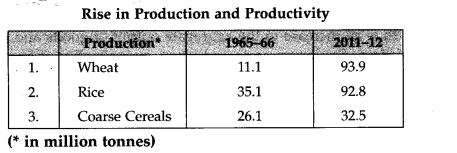NCERT Solutions for Class 11 Economics Chapter 2 – Indian Economy 1950–1990
Question 1. Define a plan.
Answer. Plan is a document showing a detailed scheme, program and strategy worked out in advance for fulfilling an objective.
Question 2. Why did India opt for planning?
Answer. India achieved independence in 1947. The colonial government left India in a poor, backward and stagnant situation. From that time efforts have been made to solve people’s problems in a sovereign Indian republic through a system of federal parliamentary democracy. Political independence has no meaning without economic prosperity. Planning was undertaken to sustain political independence and generate economic prosperity.
Question 3. Why should plans have goals?
Answer. Plans should have goals or objectives which the country wants to achieve in a specific time period. Without goals, the planners would not know which sector of the economy should be developed on a priority’basis.
Question 4. What are miracle seeds?
Answer. Miracle seeds are the high yielding variety of seeds which combined with assured water supply, fertilizer, insecticides, etc. would result in high production levels.
Question 5. What is marketable surplus?
Answer. It is that part of the agricultural produce which is sold in the market by the farmer.
Question 6. Explain the need and type of land reforms implemented in the agriculture sector.
Answer. In India, there existed a large army of middlemen like zamindars, mahalwars and ryotwars, who collected rent from the actual cultivators and deposited a part of it to the government as land revenue. They treated cultivators as slaves. The measure of abolition of intermediaries was adopted to make direct link between actual tillers and government, and to pass forests, wasteland, etc. to state government.
Tenancy Reforms are concerned with:
(a) Regulation of Rent
(b) Security of Tenure
(c) Ownership Rights for Tenants.
Reorganisation of Agriculture is concerned with:
(a) Redistribution of Land
(b) Consolidation of Holdings
(c) Co-operative Farming.
Question 7. What is Green Revolution? Why was it implemented and how did it benefit the farmers? Explain in brief.
Answer. Green Revolution. This strategy, which was launched in October 1965, has been given different names such as, New Agricultural Strategy (NAS), or Seed-Fertilizers Water Technology.
Before adopting the New Agricultural Strategy (NAS), the state of Indian agriculture was as follows:
(a) there was low and erratic growth,
(b) there was extreme regional unevenness and growing interclass inequality,
(c) there were serious droughts for two consecutive years
(d) there was a war with Pakistan
(e) USA denied India PL 480 imports.
India decided to get rid of this dependence on foreign aid in such a vital matter as food supply.
And that was the genesis of our Green Revolution, i.e., biochemical technology to step up output per acre by using scientifically inclined techniques and methods of production.
Benefits of Green Revolution.
(i) Increase in Income. Since the Green Revolution was limited to wheat and rice for a number of years, its benefits were enjoyed by wheat and rice growing areas of Punjab, Haryana, Western Uttar Pradesh and Andhra Pradesh. The income of farmers in these States grew sharply. Green Revolution succeeded in removing rural poverty in these States.
(ii) Impact on Social Revolution. Along with economic revolution there was a social revolution. The old social beliefs and customs were destroyed and people were willing to accept changes in technology, seeds and fertilizers.’ The traditional methods of farming were transformed into modern methods of farming.
(iii) Increase in Employment. Green Revolution solved the problem of seasonal unemployment to a great extent because with the possibility of growing more than one crop on a piece of land, more working hands were needed throughout the year. Also, package inputs reqired better irrigation facilities which raised the employment rate.
Question 8. Explain ‘growth with equity’ as a planning objective.
Answer. Economic Growth is an increase in the aggregate output of goods and services in a country in a given period of time. Equity refers to reduction in inequality of income or wealth, uplifting weaker sections of the society and equal distribution of economic power. Higher levels of growth and social justice are two main objectives of India’s economic planning. When these two objectives are clubbed together, it is called development with social justice.
Question 9. Does modernisation as a planning objective create contradiction in the light of employment generation? Explain.
Answer. Modernisation as a planning objective implies use of advanced technology. Advanced technology requires less labour per unit of output. Thus, modernisation creates unemployment.
Question 10. Why was it necessary for a developing country like India to follow self-reliance as a planning
objective?
Answer. On the eve of independence, India was poor, stagnant and backward. There were heavy imports of foodgrains. It was important to be self-reliance.
Features of Self reliance are:
(a) Self-sufficiency in foodgrains.
(b) Fall in foreign aid and reduced dependence on imports which is possible when there is growth in domestic production.
(c) Rise in exports.
(d) Rise in contribution of industries in grass domestic product.
Question 11. What is sectoral composition of an economy? Is it necessary that the service sector should contribute maximum to GDP of an economy? Comment.
Answer. The contribution made by each of these sectors in the GDP of a country is called sectoral composition of the economy. If the service sector or tertiary sector contributes maximum to GDP of an economy, then the country is economically developed.
Question 12. Why was public sector given a leading role in industrial development during the planning period?
Answer. Public sector has been playing a very significant role in the development of industries in the following way:
(a) Creation of a strong industrial base.
(b) Development of Infrastructure.
(c) Development of backward areas.
(d) To mobilise savings and earn foreign exchange.
(e) To prevent concentration of economic power.
(f) To promote equality of income and wealth distri-bution.
(g) To provide employment.
(h) to promote import substitution.
Question 13. Explain the statement that green revolution enabled the government to procure sufficient foodgrains to build its stocks that could be used during times of shortage.
Answer. Green revolution refers to the tremendous increase in agricultural production and productivity that has come about with the introduction of new agricultural technology. It transformed the economy of scarcity into an economy of plenty.
Rise in Production and Productivity. Green Revolution helped in removing continuing food shortages. HYVP was restricted to only five crops namely, wheat, rice, jowar, bajra and maize. Commercial crops were excluded from the ambit of the new strategy. Substantial increase in wheat production was noticed.
The wheat production increased from 11.1 million tonnes in the Third Plan to 93.9 million tonnes in 2011-12.
Rice production initially increased slowly and later at a fast pace. The production increased from 35.1 million tonnes in the Third Plan to 92.8 million tonnes in 2011-12.
The production of coarse cereals (jowar, bajra and maize) fell to 26.1 million tonnes in 1965-66 and then increased to 32.5 million tonnes in 2011-12.
Question 14. While subsidies encourage farmers to use new technology, they are a huge burden on government finances. Discuss the usefulness of subsidies in light of this face.
Answer. Subsidy is an economic benefit, direct or indirect, granted by a government to domestic producers of goods or services, often to strengthen their competitive position against foreign companies.
It helps farmers to buy HYV seeds, fertilizers and other inputs. The burden of granting subsidies falls on the government. The government has to bear the burden of financing subsidies.
There is scope for improving the resource use efficiency by reducing subsidies and aiming them better to small farmers and regions lagging behind.
Question 15. Why, despite the implementation of green revolution, 65 per cent of our population continued to be engaged in the agriculture sector till 1990?
Answer. The structural change in composition of GDP shows that India is on the path of sustained devel- opihent. But the occupational structure pattern shows that India is still underdeveloped. When nearly 60.8 per cent of the working force is engaged in agriculture where productivity is low and employment uncertain this would surely lead to low per capita income and widespread poverty for the rural masses which form about 72.2 per cent of India’s population. It also means that ex¬cessive pressure of population on land would be a hindrance in the way of productivity improve¬ment in agriculture sector.
Question 16. Though public sector is very essential for industries, many public sector undertakings incur huge losses and are a drain on the economy’s resources. Discuss the usefulness of public sector undertakings in the light of this fact.
Answer. Though many public sector undertakings are incurring huge losses, they are still very useful in the areas of strategic concerns and hazardous chemicals. Public sector undertaking are required for:
1. Creation of a Strong Industrial Base
2. Development of Infrastructure
3. Development of Backward Areas
4. To Mobilise Savings and Earn Foreign Exchange
5. To Prevent Concentration of Economic Power
6. To Promote Equality of Income and Wealth Distri-bution
7. To Provide Employment
8. To Promote Import Substitution.
Question 17. Explain how import substitution can protect domestic industry.
Answer. The import substituting industrialisation was the objective of second FYP (1956-61) till the Seventh FYP (till 1990). The Mahalanobis strategy of development was based on import substitution. The rationale of the import substitution strategy is based on infant industry argument. It helped to save foreign exchange by drastically reducing import of goods. The foreign exchange saved was to be used for the developmental imports such as capital goods, sophisticated technology, etc. It created a protected market and large demand for domestically produced goods.
Question 18. Why and how was private sector regulated under the IPR 1956?
Answer. Private sector was given minimum role in IPR 1956. New industry could start operation after it had obtained licence from the government. Licence was given after scrutiny by the government.
Question 19. Match the following:
Answer. 1. (C), 2. (D), 3. (B), 4. (E), 5. (A), 6. (F).





